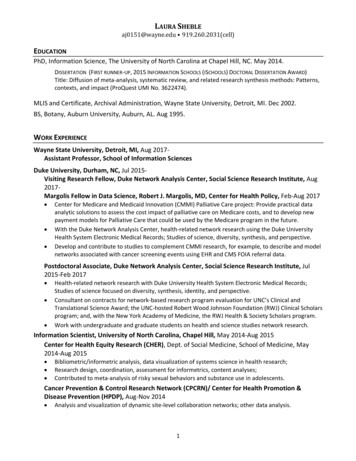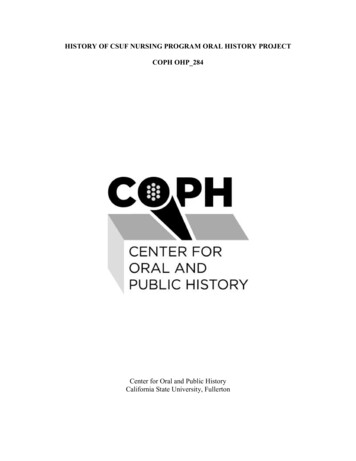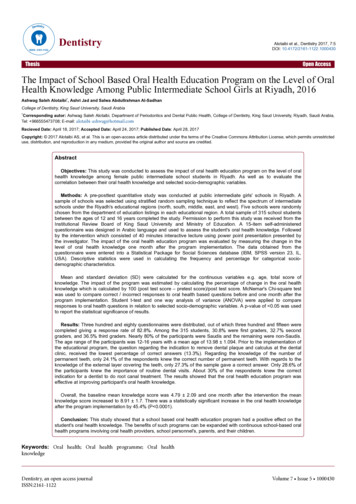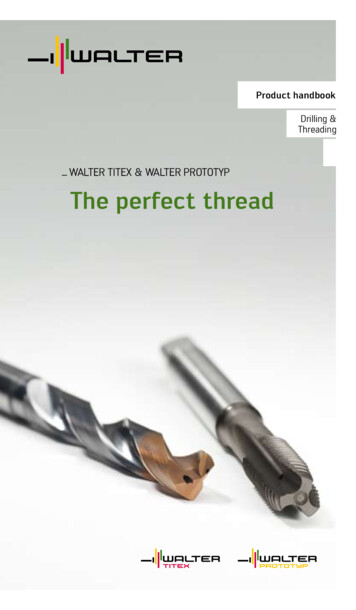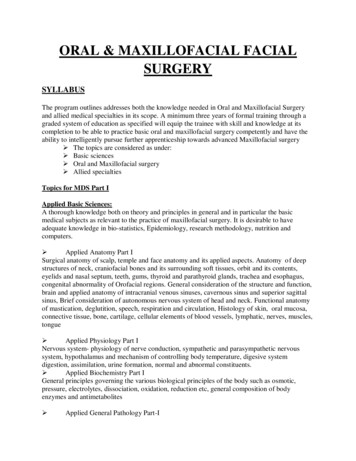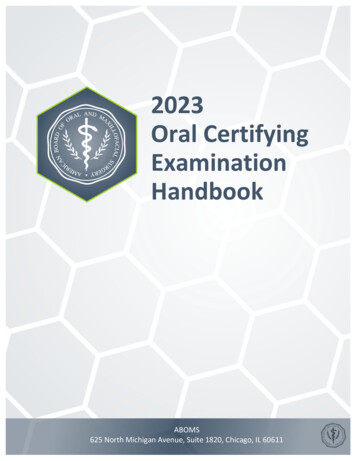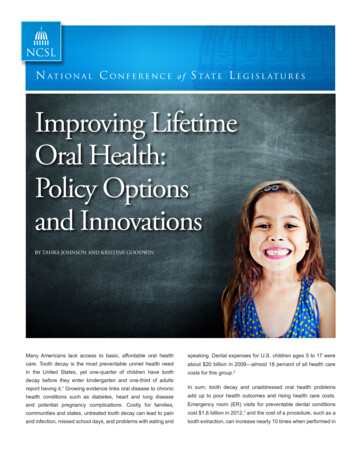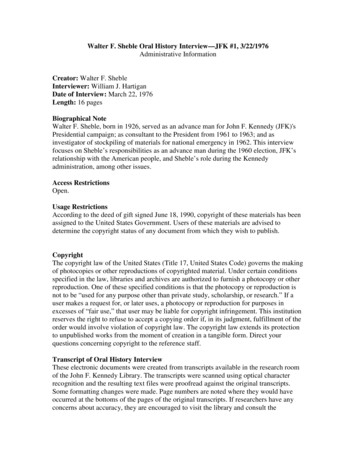
Transcription
Walter F. Sheble Oral History Interview—JFK #1, 3/22/1976Administrative InformationCreator: Walter F. ShebleInterviewer: William J. HartiganDate of Interview: March 22, 1976Length: 16 pagesBiographical NoteWalter F. Sheble, born in 1926, served as an advance man for John F. Kennedy (JFK)'sPresidential campaign; as consultant to the President from 1961 to 1963; and asinvestigator of stockpiling of materials for national emergency in 1962. This interviewfocuses on Sheble’s responsibilities as an advance man during the 1960 election, JFK’srelationship with the American people, and Sheble’s role during the Kennedyadministration, among other issues.Access RestrictionsOpen.Usage RestrictionsAccording to the deed of gift signed June 18, 1990, copyright of these materials has beenassigned to the United States Government. Users of these materials are advised todetermine the copyright status of any document from which they wish to publish.CopyrightThe copyright law of the United States (Title 17, United States Code) governs the makingof photocopies or other reproductions of copyrighted material. Under certain conditionsspecified in the law, libraries and archives are authorized to furnish a photocopy or otherreproduction. One of these specified conditions is that the photocopy or reproduction isnot to be “used for any purpose other than private study, scholarship, or research.” If auser makes a request for, or later uses, a photocopy or reproduction for purposes inexcesses of “fair use,” that user may be liable for copyright infringement. This institutionreserves the right to refuse to accept a copying order if, in its judgment, fulfillment of theorder would involve violation of copyright law. The copyright law extends its protectionto unpublished works from the moment of creation in a tangible form. Direct yourquestions concerning copyright to the reference staff.Transcript of Oral History InterviewThese electronic documents were created from transcripts available in the research roomof the John F. Kennedy Library. The transcripts were scanned using optical characterrecognition and the resulting text files were proofread against the original transcripts.Some formatting changes were made. Page numbers are noted where they would haveoccurred at the bottoms of the pages of the original transcripts. If researchers have anyconcerns about accuracy, they are encouraged to visit the library and consult the
transcripts and the interview recordings.Suggested CitationSheble, Walter F., recorded interview by William J. Hartigan, on March 22, 1976, (pagenumber), John F. Kennedy Library Oral History Program.
NATIONAL ARCHIVES ANO RECORDS ADMINISTRATIONJOHN F. KENNEDY LIBRARYLegal Agreement Pertaining to the Oral History Interviews ofWalter ShebleIn accor dance with the provisions of Chapter 21 of Title 44, UnitedStates Code, and subject to the terms and conditions here inafterset forth, I, Walter Shebl e do hereby give, donate, and convey tothe United States of America all my rights, title, and interest inthe tape recording and transcript of personal interviews conductedon March 22, 1976 at Washington, o.c . and prepared for deposit inthe John F. Kennedy Library. This assignment is subject to thefollowing terms and conditions:{1) The transcript shall be made available for use byresearchers as soon a s it has been deposited in the John F . KennedyLibrary.(2) The tape recording shall be made available to thoseresearchers who have access to the transcript .(3) I hereby assign to the United States Government allcopyright I may have in t he interview t r anscript and tape .(4) Copies of the t ranscript and the tape recording may beprovided by the Library to researchers upon request.(5) Copies of the transcript and t ape recording may bedeposited in or loaned to institutions other than the John F .Kennedy Library.DonorClh lf&3J1 -.Archivi st of the United States;;;; / / ?/'fqDate/
Walter F. Sheble—JFK #1Table of ContentsPage1234712131516TopicSheble’s first acquaintance with John F. Kennedy (JFK)Sheble’s role as an advance man for JFKWork of “Kennedy hostesses”JFK as a man of the peopleSheble’s work in investigating mineral and material stockpile in regards tonational securityJFK’s views on leadership and constraintSheble’s role in Kennedy administrationReaction to JFK assassinationJFK’s legacy
Oral History InterviewwithWALTER SHEBLEMarch 22, 1976Washington, DCBy William J. HartiganFor the John F. Kennedy LibraryHARTIGAN:This is Bill Hartigan [William J. Hartigan] inWashington, D.C.The date is March 22, 1976 andI'm in the office of Walter Sheble, S-H-E-B-L-E,an attorney in Washington, D.C., former chairman of the YoungLawyers (District of Columbia Bar Association], chairman ofthe Young Lawyers (American Bar Association Convention] backin 1960 and currently Assistant to the General Counsel of theInter-American Development Bank in Washington, D.C.I'm inthe office of Walter Sheble and I'm interviewing him on behalfof the oral history department of the John F. Kennedy Libraryin Boston, Massachusetts. Walter, when did you first come incontact with John F. Kennedy or his organization?SHEBLE:Bill, I think it was about in May or June of 1960when a number of us, Tom Powers (N. ThompsonPowers], I remember, and John E. Nolan (John E.Nolan, Jr.] attempted to get to then Senator Kennedy to makean appearance in suburban Maryland at -- and that appearancedid occur during that time in Wood Acres Elementary School.I'm ashamed to say that I didn't -- I'm not sure that Iattended --I can't recall whether I did -- I was busy with anumber of things that particular year leading up to theconvention here of the Younger Lawyers section in July andAugust of 1960. The second time when I shook hands with him,however, was a meeting in another school that John Nolanadvanced himself in Montgomery County near Silver Spring, andI shook hands with the senator at that time.HARTIGAN:Walter, you were active after you got relieved ofsome of your responsibilities as head of the YoungLawyers in the Washington, D.C. Bar Association.What were your activities during the 1960 campaign?SHEBLE:Bill, after the American Bar convention was over Ican recall sitting around the Shoreham pool -John Nolan, myself, and Tim May. The telephonerang and Nolan answered the phone and he said this is KennethO'Donnell [P. Kenneth O'Donnell] and he needs somebody to
2advance a Houston conference of Baptist preachers; and I stillhad clean-up activities to do for the convention and John wasengaged and Tim May said he'd like to do it, and he would haveto check with his firm which was Covington and Burling at thattime and he did, in fact, do that job. The next time I camein contact was when John called me in late October and askedme if I'd like to do some advance work.I said "Sure, I'llhave to get leave from my office." During 1960 I participatedin a national security amendment case with the Japaneseelectronics industry, which required a considerableconcentration of my own particular time, so it wasn't untilOctober that I could free myself up, and at that time Iundertook my first advance. the interruption, but we do(Interruption]Youhave to change our tapes once in a while.were about to tell us about your first advance,would you continue. please?HARTIGAN:SHEBLE:Thanks, Bill. John called up and he asked me ifI'd like to go to Michigan.I said, "That'sfine," and he handed me the instructions foradvance men, which I have here, written by Tom Finney andMarty Friedman (Martin Friedman] -- a very comprehensive,thirty-two page manual -- I guess one of the originalmanuals -- and then a work-sheet to be filled out ah, thedetails of the schedule, and I see you're mentioned veryprominently throughout all these things, as you were in allthe efforts for President Kennedy . . . Bill . . . I went toDetroit to the Cadillac Hotel, knocked on the assigned door,and somebody said, "Come in." I opened the door, and, therewas a stocky gentleman standing in his shorts . . speakingloudly over the phone to a lady whom he called Millie (MildredJeffrey] at various times. He turned around and looked at meand I had my old grey flannel suit and he said . . . he said"Are you that Princeton boy that John Nolan sent up here tohelp me?" And I said, "Yes sir." And it was my first meetingwith Jerry Bruno (Gerald J. Bruno] who has been a closeacquaintance, if not friend of mine, and whose friendship I'dvalued over the years. Jerry was the head of the advance teamin Michigan. His assistant that time was Mel Cotton (MelloCotton]. I was assigned to do a shopping center in MacombCounty, Eastgate, specifically, in a little city calledRoseville. The shopping center was the ordinary type shoppingcenter, shaped something like a horseshoe, with the stores atthe back of the -- of the -- semi-circle. And we began, atthat time, to make the arrangements for the -- for thematerials and for -- the uh -- the press accommodations andbuilding a platform, and so forth. We had a very energeticgroup of people. There was a great deal of excitement. Therewere a number of disagreements as to exactly where we wouldput the -- where we would put the stand and so forth and so
3on. One of them, I understand, not in my presence, wassettled outside the hall, one that was a little disputebetween the mayor and the local coordinator!In any event,uh, the preparations proceeded rather smoothly. I can recalla number of the specific, uh, instructions I had from Mr.Bruno. Mr. Bruno, uh, Jerry Bruno said, "Now, boy, you wantto be sure and get a ladies committee organized and thesepeople are going to be Kennedy hostesses." And I said, "Howmany hostesses are there going to be, Jerry?" And he said,"Well, if you have 10,000 women, they're all going to behostesses, and they're all going to have badges." And I said,"Jerry, what does a badge look like?" He said, "You want meto get some ribbon -- for the badge?" I said, "And how do youattach the badge to the woman?" He says, "I tell you what youdo. You go get 10,000 little cards printed up, called'Kennedy Hostess,' with a picture of the senator [Kennedy] onit and a straight pin," and he says, "that's your badge." SoI went out and got 10,000 cards printed up with 'KennedyHostess' and 10,000 straight pins and we handed them out tothe -- and had them distributed and every woman there was aKennedy Hostess and, I'm sure, proud to be a Kennedy Hostess.We made the usual arrangements for the Kennedy girls, who weredressed all in white, with the red, white and blue papermache stripes. Now we get to the particular day which wasOctober 26, Wednesday, October 26, at 3:30 P.M. The flyer Ihave here, Bill, says, "Hear Hirn Here, Eastgate ShoppingCenter, Frazho and Gratiot, Wednesday, October 26, SenatorJohn F. Kennedy, Your next President" and of course, at thebottom of it has the union bug on it, which was always usefuland important -- we got a lot of help from the UnitedAutomobile Workers because that was a United AutomobileWorkers territory in the Michigan area. The day came and thestands were prepared and the people flocked in. By about twoo'clock, I think I had twelve thousand people in the shoppingcenter. By the time the senator arrived at three-thirty, wehad fourteen, maybe fifteen thousand.They were all overGratiot Avenue, the shopping center was packed -- it was justfull of people, there was not an inch, inch to move in.Someof the interesting things that happened . . . . According toJerry's instructions, we had a band, the band played for anhour, and people sang. We had a cordonwe cordoned offspace with the local police authorities so that when thesenator's car came in, he could get out of the car and then wehad a walkway which was -- went up to the stand which wasroped off.I remember checking the stand and going up thewalkway and, from back in the crowd, a very tall,distinguished man raised his head.He had a bowler hat on anda Chesterfield and he was -- there weren't too many dressed aswell as he was, and he was handing his, his calling card up inthe air, and I motioned him to come over and he came throughthe crowd. He handed me his calling card and, Bill, I wish Icould remember the gentleman's name, but, it said Associate
4Justice, Supreme Court, State of Michigan, Justice so-and-so.He said to me, "Sir," he said, "I would like to standsomeplace convenient where I could see this great man." And Isaid, "Yes, sir, you can stand right here," and I made a placefor him so he could stand in the crowd, but where he couldhave a good view of Senator Kennedy. And then, Bill, itrained. And I never saw so much rain in my life; it was acomplete downpour -- a downpour! And, the Kennedy girls stoodthere -- everybody stood as though they were fixed inconcrete; not a one person moved out of that place; some ofthem got back underneath the awnings, but we lost none of thecrowd.[Laughter] The white, the white dresses turned asthe, as the paper-mache -- the red, white and blue papermache -- melted away, the white, Kennedy girls' [Laughter]dresses changed to all different colors and they stood thereand those lovely ladies were soaked right through to the skin,but they held their ground. And, just as the sirens wereheard down Gratiot Avenue, the sun came out and it was abrilliant, sunny afternoon as the then senator, John Kennedy,approached the Eastgate Shopping Center, and, as usual, as themanual says, the candidate never rides in the Cadillac -- thecandidate always rides in the small convertible, with the topdown. Here came the senator in the convertible and into theshopping center. Well, as generally happens in theseadvances, unfortunately, the cordon rope did not hold and thelocal police officers melted into the crowd as the ropes felland Senator Kennedy got out of the car.I walked up to himbecause the crowd was so -- was pressed all around him and Icouldn't see exactly how he was going to get to the stand, andI took him -- I touched him gently on the, on the left elbowand I said, "This way to the stand, Senator," and he looked atme very briefly and he said quietly, and, but veryconvincingly, "Damnit, Walter, let go of my arm." And, I'lltell you, I was honored that he knew my name and I learned alesson at that time, and, that is, that he wanted to go wherehe wanted to go so that he could meet the people . . and -that was one of his great, as I saw in later years -- he knewthe people and he wanted to meet the people and he knew wherehe wanted to go and that was part of his job to do. Heproceeded right into the middle of the crowd -- he walked outin front of the stand -- into fourteen thousand people andthey were all jumping and I'm not quite sure how we ever gothim back to the stand. We did, in fact, get him back to thestand, and -he addressed the crowd and gave one of thosestirring speeches of, maybe, ten minutes or fifteen minutesthat just enthused and inspired a crowd, as he could. Afterthat, he got in the car, I had an old coat on, I got some ofthe red, white and blue bunting on my coat -- I still have thecoat today, Bill, with the red, white and blue smeared allover the thing from the rain, and I said goodbye to my friendsand I was trying to catch the last bus and I almost -- MillieJeffrey keeps telling me this every time she sees me.I ran
5and ran after that bus and I finally got up to the door andthe bus stopped and I got in front of the bus and I fell rightdown into the mud and almost drowned in the puddle, (Laughter]in front of the thing, and everybody on the bus was screamingand hollering, laughing, and I was the big hit of the show,and I finally did get in the bus and went back down to town;we went to the Cadillac Hotel while the senator rested.HARTIGAN:SHEBLE:Walter, before we get off the Roseville advance,who else was on that advance trip with you, do yourecall?Yes, Jerry was the head, and Mel Cotton was hisdeputy, Bob Martin did Birmingham, Michigan, I didRosedale; there were other distinguished peoplearound. At that time, I can recall that Congressman JamesO'hara (James Grant O'hara) was a freshman congressman -- wemet in his off ice, which was close to Rosedale, and he did, infact, represent that particular area; and then Adam ClaytonPowell -- Congressman Adam Clayton Powell -- was there, andpossibly some others that I don't recall.The major event inDetroit that evening was the appearance of Senator Kennedy inthe Detroit Coliseum. That particular job had been worked byMel Cotton and Jerry, and we -- my participation was minimal;I had certain assignments within the Coliseum with referenceto crowd control, and those types of things.I do remember,however, the Coliseum was a very large auditorium; it wasfairly well packed, but it was raining.The rain, which hadcleared up and let the beautiful sunlight in my particularassignment, reoccurred in the evening and it created reallyadverse conditions around the Coliseum to move the candidatein and out. The mud was right, way up over my shins and belowmy knees, as I recall, as we were walking with the car goinginto the Coliseum.Corning out of the Coliseum after thetalk -- the speech, Senator Kennedy decided that he would goto Hamtramck.It had been a great wish and desire of thepeople of Hamtramck to have the candidate appear, and it was alast minute decision on his part, and I know that was anexciting experience -- I think Eddie Dragon [Edward A. Dragon]went along on that and knows a little bit more than I did; Idid not go on it -- I remember helping get the senator throughthe crowd into his car, into this mud, and everybody was stuckin the mud and the car was down in the mud and we pushed thecar to get it out of the mud and off he went to Hamtramck, andthat was the end of that particular day in Detroit, Michigan.As I recall, I don't think Ed was -- Ed Dragon -- was not onthat advance and you'll be talking to him tomorrow, so you canclear up that point -- I believe he was working the phone -the scheduling phone -- with the great Richard O'Hare at thattime.Subsequent to that period, I checked in to Mr. O'Hare'soff ice and there was a great -- since the advance in Michiganhad been very -- or, at least, let me say -- since the -- not
6the advance -- but since Senator Kennedy had been received soenthusiastically in Michigan and since we had the cooperationof everybody, there was a serious consideration of bringinghim back maybe for the next to last or last appearance, and Iwas instructed to remain in Michigan and attempt to coordinatewith Millie Jeffrey and the then chairman of the party, Mr.Staebler [Neil Staebler] to set up the possibilities of asecond, and final, appearance by Senator Kennedy. Ah . . . .Walter, you mentioned the name of Staebler, thatis the Staebler who is currently a member of theFederal Election Commission, is that correct, anda f orrner congressman?HARTIGAN:SHEBLE:Yes, sir, that is. He was one of the greatchairmen of the Democratic Party, as you recall.We worked closely with Millie Jeffrey, who was oneof the great national committeewomen of the party -- she didmost of the actual coordination between myself and -- well,Mr. Bruno and myself and the other people in the field andalso an assistant to the then governor by the name of MaureyConnell [Maurice J. Connell] was another person we workedwith.HARTIGAN:Walter, you were assigned by Dick O'Hare to stayin Detroit for a potential visit -- last minute ·visit by the president to wind up the campaign - would you tell us about that particular assignment?SHEBLE:Well, that assignment just had me -- required justchecking with Millie Jeffrey and the other leadersof the party in Michigan and back and forth withDick O'Hare and Ed Dragon on the phone as to the possibilityof the assignment of corning out, corning forth.As a result ofother strategy and tactics, the assignment never came and Ifound myself without an advance and without the pleasure ofparticipating again with my friends in a further appearance bythe senator.I can't recall when I came back to Washington,but it probably was in the first couple of days of November - I think I was in Michigan a total of maybe, twelve days.HARTIGAN:Those things happen, I suppose, in campaigns whereyou have to plan them even though, sometimes, youdon't utilize the talents that we used inadvancing, but you can't wait until the last minute; you dohave to have -- you probably have more than planned than youuse anyway. Walter, did you advance any other cities duringthe campaign or was that . . . ?SHEBLE:No, Bill, I didn't advance any other cities; I,ah, when I came back to Washington, I went rightback into my work, there were only two of us, and
7we had a pretty heavy load of cases to work; in any event, itwas right close to the election.HARTIGAN:Did you participate in any of the inaugurationactivities between the election and theinauguration?SHEBLE:I participated in the festivities that the advancemen were invited to and I was pleased toparticipate in those; I'm not sure that I -- Ican't recall -- I'm pretty sure I didn't have any officialcapacity or any official jobs assigned to me at that time,although I do vaguely recall something about a -- some kind ofadvance of a gala, but I'm very hazy on that.I would saythat I didn't have anything to do -- I know it snowed likecrazy during that period and that was some experience throughthe inaugural itself.HARTIGAN:After President Kennedy took off ice, did youparticipate in any way in the administration afterhe took his oath of off ice?SHEBLE:Yes, I did, Bill. There came a time when thepresident became concerned about the minerals andmaterial stockpile -- the size of the stockpile,how it was acquired, and the cost to maintain it and theutility of the materials that were contained therein. Threeof us, Tim May, Ed Dragon and myself were asked to participatein making a survey of that particular situation, and, as aresult of the president's concern, Senator Stuart Symington,who was Chairman of the Stockpile and Naval Petroleum ReserveCommittee, Subcommittee of Armed Services, undertook a surveyalong those areas and the three of us were assigned to beavailable to Senator Symington and his counsel, RichmondCoburn, whom I had known, a distinguished member of the Boardof Governors, the American Bar Association, and whom I hadknown personally in my work with the Younger Lawyers section.HARTIGAN:SHEBLE:Walter, what were the particular objectives thatyou and Tim -- Tim May -- and Ed Dragon had inthis investigation?I think that the president was concerned, as Isaid, of the size of the size of the minerals andmaterials that were stockpiled. At the time webegan our investigation, there were over eight billion dollarsstored at a cost of 250 million dollars a year to store them;I think that figure is correct -- it may have been a littleless -- and there was a substantial question as to the utilityof certain of the commodities that were stored and whether, infact, the present war plan required that much material, andif, in fact some of these couldn't be disposed of with the
8resulting gain to the U. S. taxpayer in the sale of thecommodities and the savings in the storage of the commodities.For instance, with reference to natural rubber -- I think thefacts sustain that we had enough natural rubber for fiftyyears' full use for industry and government, and that was justmore natural rubber than was conscionable for us to haveacquired or to hold. My particular area of concentration wasin areas such as lead and zinc.I did the lead and zinc studyand made recommendations in general with reference tostockpile policy, as did Tim May and Ed Dragon.I made someinteresting findings which are all incorporated in thehearings and the final report.I was particularly interestedin two things -- let me correct that, Bill -- I was interestedin several things; first was lead and zinc, and then, what Ithought was very basic, the standards for acquisition ofstockpile materials. Let me take the latter one first.Stockpile materials were acquired as a result of an estimateby people in the Department of Defense, the Department ofCommerce and the Department of Interior as to how much of aparticular material we might need for a particular timeperiod. Generally, they said one year's full supply for a warperiod. And then, that was factored by what type of a war wewere gonna fight.Now, this was in 1962.I made a survey ofthe concepts with reference to the particular war plan, and Ifound out that up until 1958, the war plan with reference tothe acquisition of minerals and materials, was based on afive-year conventional war. Now this was in the time of thedevelopment of atomic weaponry and the whole DefenseDepartment had geared themselves to fighting limited wars ofshort time duration, and yet, the stockpile conditions calledfor a five-year full scale war. This, of course, increasedthe need for minerals and materials and this, as I said, thiscondition held until 1958, when it was removed by Grodon Gray,who indicated in the memorandum, that this was ridiculous andthat President Eisenhower would "hit the roof" if he thoughtthat this type of acquisition of materials was going intogovernment's stores at such a cost.Then, with reference to the lead and zinc investigation, Ifound that there was considerable lead and zinc. The hearingrecord bears out that it was the -- that lead and zinc wasacquired for the purpose of supporting the price of lead andzinc. At the beginning of acquisition for the stockpile, theprice was nine and ten cents a pound; at the termination, orwhen we were through -- or at the height, let me say -- at theheight of the acquisition, the price was fourteen and sixteencents a pound. This substantially raised the price for leadand zinc and the administrators, during that period, felt thatthis was justified -- the economic price increase in theinterest of national security -- planning, at that time, inthe late fifties, for a full, five-year war.I do recall thatthe head of the stockpile, the assistant-secretary of the
9interior at that time, · was the vice-president of the st.Joseph's Lead Company, and he was brought to Washington,specifically, for a short period, to assist in the acquisitionof these various materials -- not only lead and zinc -however, his company received a very substantial order forlead and zinc, as did other companies, and he testified,himself, that he thought that raising the price of lead andzinc through these substantial acquisitions was in thenational interest and that's why he recommended increasingsupplies of lead and zinc.I might say that something thatdidn't come out at the . . .HARTIGAN:Walter, we had to change tapes again, I want toexcuse the interruption. You were talking about - just a second -- the assistant-secretary of the. Interior, I believe, during the time of stockpiling.SHEBLE:Something that didn't come out of the hearing,which I think is interesting, was, of course, thatthe assistant-secretary of the interior just priorto that time, was the vice-president of one of the leadingminerals -- lead companies -- and, it was through hisassistance -- insistence -- that such large amounts of leadand zinc were purchased and the price rise, rose rathersignificantly. At the same, this same time that he came toWashington, the lead industry was under investigation forprice fixing by the Justice Department. Another one of theinteresting factors, Bill, is that in getting information fromthe Commerce and the Interior department, we ran into asituation where we would open the door and walk in and talk toa person and we would find that we'd been talking -- we'dtalked to a person who had just been brought to Washington -maybe the week previously he was a dollar-a-year man -- and herepresented, or was an official of, the particular companythat, or industry in which we were interested in. This led toa executive order on special consultants by President Kennedywhich effectively abolished the dollar-a-year type person. Ican remember Gene Foley [Eugene P. Foley) who was the thenassistant-secretary of commerce, calling me and saying,"Walter," he said, "Geez, I don't know who's in thoseoffices," he said, "Every day I walk in, there are differentpeople there I see; I can't really tell who's in there." Andthat led to concern by the president, with reference topossible conflicts of interest and an executive orderinvolving conflicts of interest.HARTIGAN:Walter, this begins to sound like the case ofputting the fox in charge of the chicken coop.Inthe light of that, could you tell me, from yourobservations during the investigation, did you see any signsof the Eisenhower administration trying to take steps tocorrect this unusual situation in stockpiling?
10SHEBLE:The steps, the only steps I saw were made verylate in the game, in 1958, and that particularstep was to correct, to correct the concept ofpossible conditions of national emergency or the war plan thatapplied to stockpile, when Mr. Gordon Gray said that it wasfoolish to think that we would fight a five year -- a war offive year duration and the war period was cut back, as Irecall, to a third year -- a three year war. We held ahearing, specifically, with a consultant from the HudsonInstitute, Dr. Stephen Enke, who was a specialist on possibleconditions of military emergency affecting the United States.It was his conclusion that, even three year war, was difficultto envisage, and it would be better to concentrate stockpileacquisition on atomic catastrophes, or on very short, brushfire type, wars in distant lands.To answer your question, specifically, there was a smallamount of -- small attempt to rectify the situation, but, overthe total period from '52 through 1 58, the attempt was,specifically, to build up the stockpile to the maximum extentpossible.HARTIGAN:Walter, the situation seems to be -- to have beena very serious one and, of course, legallyquestionable; as a result of the investigation,
WALTER SHEBLE March 22, 1976 Washington, DC By William J. Hartigan For the John F. Kennedy Library HARTIGAN: This is Bill Hartigan [William J. Hartigan] in Washington, D.C. The date is March 22, 1976 and I'm in the office of Walter Sheble, S-H-E-B-L-E, an attorney in Washington, D.C., former chairman of the Young
